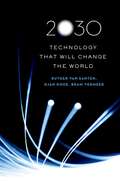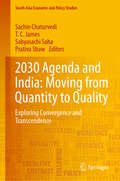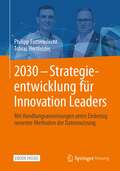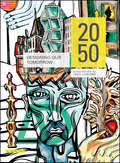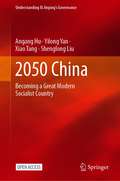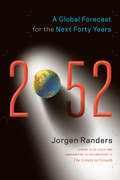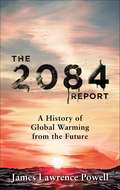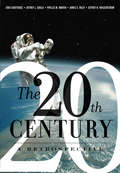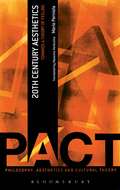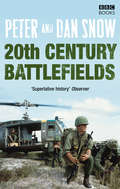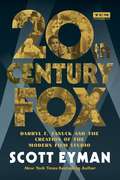- Table View
- List View
2030: Technology That Will Change the World
by Rutger van Santen Djan Khoe Bram VermeerImagine living in 1958, and knowing that the integrated circuit--the microchip--was about to be invented, and would revolutionize the world. Or imagine 1992, when the Internet was about to transform virtually every aspect of our lives. Incredibly, this book argues that we stand at such a moment right now--and not just in one field, but in many. In 2030, authors Rutger van Santen, Djan Khoe, and Bram Vermeer interview over two dozen scientific and technological experts on themes of health, sustainability and communication, asking them to look forward to the year 2030 and comment on the kind of research that will play a necessary role. If we know what technology will be imperative in 2030, the authors reason, what can we do now to influence future breakthroughs? Despite working in dissimilar fields, the experts called upon in the book - including Hans Blix (Head of the UN investigation in Iraq), Craig Venter (explorer of the human DNA), and Susan Greenfield (a leading world authority on the human brain), among many others - all emphasize the interconnectedness of our global networks in technology and communication, so tightly knit that the world's major conflicts are never isolated incidents. A fresh understanding of the regularities underlying these complex systems is more important than ever. Using bright, accessible language to discuss topics of universal interest and relevance, 2030 takes the position that we can, in fact, influence the course of history. It offers a new way of looking forward, a fresh perspective on sustainability, stability and crisis-prevention. For anyone interested in modern science, this book will showcase the technologies that will soon change the way we live.
2030: Technology That Will Change the World
by Rutger van Santen Djan Khoe Bram VermeerImagine living in 1958, and knowing that the integrated circuit--the microchip--was about to be invented, and would revolutionize the world. Or imagine 1992, when the Internet was about to transform virtually every aspect of our lives. Incredibly, this book argues that we stand at such a moment right now--and not just in one field, but in many. In 2030, authors Rutger van Santen, Djan Khoe, and Bram Vermeer interview over two dozen scientific and technological experts on themes of health, sustainability and communication, asking them to look forward to the year 2030 and comment on the kind of research that will play a necessary role. If we know what technology will be imperative in 2030, the authors reason, what can we do now to influence future breakthroughs? Despite working in dissimilar fields, the experts called upon in the book - including Hans Blix (Head of the UN investigation in Iraq), Craig Venter (explorer of the human DNA), and Susan Greenfield (a leading world authority on the human brain), among many others - all emphasize the interconnectedness of our global networks in technology and communication, so tightly knit that the world's major conflicts are never isolated incidents. A fresh understanding of the regularities underlying these complex systems is more important than ever. Using bright, accessible language to discuss topics of universal interest and relevance, 2030 takes the position that we can, in fact, influence the course of history. It offers a new way of looking forward, a fresh perspective on sustainability, stability and crisis-prevention. For anyone interested in modern science, this book will showcase the technologies that will soon change the way we live.
2030 Agenda and India: Exploring Convergence and Transcendence (South Asia Economic and Policy Studies)
by Sachin Chaturvedi T. C. James Sabyasachi Saha Prativa ShawThis book presents a selection of multifaceted development issues involving social, economic and environmental aspects, in order to inspire and guide implementation of the United Nations’ SDGs. It focuses on economic development, human well-being and sustainable pathways, with special attention to financial and knowledge resources, as well as measurement concepts. In doing so, the book draws a distinction between sustainability and sustainable pathways by refraining from dealing with broader and more direct environmental sustainability issues like climate change, environmental degradation and sustainable energy. The choice of topics, apart from their relevance for India, was guided by their importance in connection with multiple SDG goals. In addition to revealing the intricacies of systemic relationships and the dilemmas they create in policy choices, the book examines the role of actors and the critical importance of partnerships to help readers comprehend the breadth of diversities and inter-linkages involved. The roles of the central and state governments, the parliament and the state assemblies, the civil society, UN agencies and district-level authorities are separately explored in depth. Sharing valuable insights, the book encourages policymakers, practitioners and scholars to move towards a sustainable and equitable economy, and supports them in their efforts.
2030 - Strategieentwicklung für Innovation Leaders: Mit Handlungsanweisungen unter Einbezug neuester Methoden der Datennutzung
by Philipp Futterknecht Tobias HertfelderSeit der Relativitätstheorie wissen wir, dass massereiche Objekte durch ihre Gravitation Dinge anziehen. Je größer die Masse desto größer ist auch die Anziehungskraft. Genauso verhält es sich auch in Strategieprojekten. Jeder Projektteilnehmer ist dabei ein massereicher Teilnehmer und hat Auswirkungen auf das Zusammenspiel. Was sich gravierend geändert hat ist der Einfluss der Daten auf diesen Prozess. Wer dies nicht berücksichtigt, wird in Zukunft enorme Einbußen hinnehmen müssen. Da sich durch diese Veränderung ein neues Gleichgewicht einstellt, ändern sich auch die Erfolgsaussichten der angewandten Methoden und Verhaltensweisen. Wie Sie diesen Wandel meistern können und was Sie dazu benötigen erfahren Sie in diesem Buch.
2050: Designing Our Tomorrow (Architectural Design)
by Chris LuebkemanEnvisioning a positive future through design 2050: Designing Our Tomorrow describes the ways in which architecture and design can engage with the key drivers of change and provide affirmative aspirations for a not-so distant future. With a focal date of 2050, this issue of AD asks when and how the design community can, should, and must be taking action. The discussion centres on shifts in the urban environment and an established way of life in a world of depleted natural resources and climate change. Featuring interviews with Paola Antonelli of MoMA and Tim Brown of IDEO, it includes contributions from thought leaders, such as Janine Benyus, Thomas Fisher, Daniel Kraft, Alex McDowell, Franz Oswold, and Mark Watts. High-profile designers like FutureCitiesLab, SHoP, and UrbanThinkTank, are featured as examples of forward thinking and innovation in the field, highlighting the need for — and possibility of — a shift in the global perspective. The discussion includes the challenges we face in creating a positive tomorrow, and the solutions that architecture and design can bring to the table. Despite the proliferation of global crises possibly threatening human survival, our current moment provides the opportunity to write a new, positive story about our future. 2050: Designing Our Tomorrow describes how the design community can contribute to that vision by asserting positive aspirations for the worlds we create ourselves. See how architects and designers inspire global positive change Consider architecture's role in shaping cultural outlook Learn the key drivers of change for the built environment Explore the perspectives of leading experts and designers Architects and planners over the centuries have put a stamp upon the planet through the physical manifestations of their belief structures. Today's design community faces a rising wealth gap, climate change, shifting paradigms of nationalism, and myriad other challenges. 2050: Designing Our Tomorrow phrases global issues as a design problem, and describes how architects and designers can rise to the challenge of creating a more positive future.
2050 China: Becoming a Great Modern Socialist Country (Understanding Xi Jinping’s Governance)
by Angang Hu Yilong Yan Xiao Tang Shenglong LiuThis book is open access under a CC BY-NC-ND 4.0 license.This book is arranged and developed around the theme of “2050 China,” it analyzes the factors and advantages of the Chinese road to socialist modernization, explores and summarizes the development goal and the basic logic of the socialist modernization of China, and further shows the general basis of the primary stage of socialism. According to the report delivered at the 19th Party Congress, and according to the “two-stage” strategic plan, this book looks ahead in detail to the overarching objective and sub-objectives of essentially achieving socialist modernization by 2035, discusses the building of a great modern socialist country in all respects from the perspective of the Party’s six-sphere integrated plan of economic, political, cultural, social, ecological civilization, and national defense construction, and provides policy proposals. This book also analyzes the influence and the effect of the socialist modernization with Chinese characteristics on the world and it further presents the third centenary goal. In conclusion, this book is an elaboration of the work of the Institute for Contemporary China Studies, Tsinghua University. It reflects the intellectual innovation in the authors’ research on contemporary China, as well as the authors’ foresight and predictions about China’s future development.
The 2051 Munich Climate Conference: Future Visions of Climate Change (Neue Ökologie #8)
by Benno Heisel Andreas Wehrl Theresa Spielmann Christina WehrlIn September 2021 a very special academic conference took place: T2051MCC - The 2051 Munich Climate Conference. Researchers from across the academic spectrum assembled to discuss climate change. What made it special was that everyone held their lecture as if it took place in an imagined year 2051. The theatre collective Büro Grandezza had released an open call for contributions to a conference in Munich. Almost 50 researchers wrote papers on climate narratives, geoengineering, coastal adaptation and other topics. This particular framework allowed them to break out of the constraints of the current discourse without neglecting methodology or thematic sharpness.
2052: A Global Forecast for the Next Forty Years
by Jorgen RandersForty years ago, The Limits to Growth study addressed the grand question of how humans would adapt to the physical limitations of planet Earth. It predicted that during the first half of the 21st century the ongoing growth in the human ecological footprint would stop-either through catastrophic "overshoot and collapse"-or through well-managed "peak and decline." So, where are we now? And what does our future look like? In the book 2052, Jorgen Randers, one of the coauthors of Limits to Growth, issues a progress report and makes a forecast for the next forty years. To do this, he asked dozens of experts to weigh in with their best predictions on how our economies, energy supplies, natural resources, climate, food, fisheries, militaries, political divisions, cities, psyches, and more will take shape in the coming decades. He then synthesized those scenarios into a global forecast of life as we will most likely know it in the years ahead. The good news: we will see impressive advances in resource efficiency, and an increasing focus on human well-being rather than on per capita income growth. But this change might not come as we expect. Future growth in population and GDP, for instance, will be constrained in surprising ways-by rapid fertility decline as result of increased urbanization, productivity decline as a result of social unrest, and continuing poverty among the poorest 2 billion world citizens. Runaway global warming, too, is likely. So, how do we prepare for the years ahead? With heart, fact, and wisdom, Randers guides us along a realistic path into the future and discusses what readers can do to ensure a better life for themselves and their children during the increasing turmoil of the next forty years.
2071: The World We’ll Leave Our Grandchildren
by Duncan Macmillan Chris RapleyHow has the climate changed in the past? How is it changing now? How do we know?And what kind of a future do we want to create?
The 2084 Report: A History of Global Warming from the Future
by James PowellAs his health begins to fail, a historian in the year 2084 sets out to document the irreparable damage climate change has wrought on the planet over the course of his life. He interviews scientists, political leaders and ordinary people all around the world who have suffered its catastrophic effects, from devastating floods and mass droughts to war and famine. In a series of short chapters, we learn that much of New York has been abandoned, 50 million Bangladeshis are refugees and half of the Netherlands is under water. This is all fiction. But it is rooted in scientific fact. Written by a professor of geochemistry, James Lawrence Powell, The 2084 Report accurately chronicles the future we will face if nothing is done to address the climate crisis. A vivid portrait of climate change and its tangible impact on our lives, The 2084 Report is a powerful prophecy and urgent call to action.
209 Fast Spare-Time Ways to Build Zero Cash into 7 Figures a Year in Real Estate
by Tyler G. HicksMore fortunes are built in real estate on borrowed money than in any other business. And you can build your fortune in real estate using borrowed money too-if you follow the advice and tips in this book. Whether you're making your first foray into real estate investing or have invested for a number of years, 209 Fast Spare-Time Ways to Build Zero Cash into 7 Figures a Year in Real Estate will show you how to acquire income-producing real estate and build your wealth by using borrowed money. Long-time real estate advisor Tyler Hicks offers proven strategies and real-world examples to illustrate how much MIF-Money in Fist-you can realistically earn by investing in real estate. A valuable guide for new, experienced, or affluent real estate investors, 209 Fast Spare-Time Ways to Build Zero Cash into 7 Figures a Year in Real Estate covers all the bases, from finding loans to hiring an accountant and an attorney to help with the business. Letters from individuals who have successfully followed the strategies outlined in this book are also included to help you understand exactly what you must do to make this plan work for you. Filled with in-depth insights and practical advice, 209 Fast Spare-Time Ways to Build Zero Cash into 7 Figures a Year in Real Estate discusses important real estate topics-including creative financing, acquiring single-family homes, and becoming a private lender client-to allow you to make the most of your investments in real estate.
20th Anniversary For Dummies (For Dummies Ser.)
by Consumer DummiesThe history, statistics, and fun facts! Although yellow-and-black For Dummies books are pervasive today — found all over the world and wherever books are sold, covering subjects from Access to Zune — at one time they didn't exist at all. How did this brand come about? What juicy tidbits exist in the Hall of Memories to explain the brand's titling strategy (Dummies? I'm not a dummy!) and its unique elements like cartoons and icons? This special anniversary edition answers these questions and provides insight into how the launch of a single book in 1991 evolved into a global brand phenomenon. Open the book and find: The first book and how it came to market Decisions that helped establish the brand The role authors have played in making Dummies successful The evolution of Dummies packaging The brand around the globe Fun Dummies moments in history Learn about: The first Dummies book and how it came to be The brand's history and milestones Each book series, licensed products, memorable quotes, and more!
20th Annual Conference on Composites, Advanced Ceramics, Materials, and Structures - A (Ceramic Engineering and Science Proceedings #198)
by John B. WachtmanThis volume is part of the Ceramic Engineering and Science Proceeding (CESP) series. This series contains a collection of papers dealing with issues in both traditional ceramics (i.e., glass, whitewares, refractories, and porcelain enamel) and advanced ceramics. Topics covered in the area of advanced ceramic include bioceramics, nanomaterials, composites, solid oxide fuel cells, mechanical properties and structural design, advanced ceramic coatings, ceramic armor, porous ceramics, and more.
20th Annual Conference on Composites, Advanced Ceramics, Materials, and Structures - B (Ceramic Engineering and Science Proceedings #200)
by John B. WachtmanThis volume is part of the Ceramic Engineering and Science Proceeding (CESP) series. This series contains a collection of papers dealing with issues in both traditional ceramics (i.e., glass, whitewares, refractories, and porcelain enamel) and advanced ceramics. Topics covered in the area of advanced ceramic include bioceramics, nanomaterials, composites, solid oxide fuel cells, mechanical properties and structural design, advanced ceramic coatings, ceramic armor, porous ceramics, and more.
The 20th Century: A Retrospective (PDF)
by Choi ChatterjeeThree grand themes characterized the twentieth century: crises on a scale that outstripped any in human history; revolutionary ideology and action that brought social and political transformations on a global scale; and new technologies breathtaking in their pace and innovation. It was a century of triumphant creativity and achievement, yet it witnessed violence and destruction of appalling, even cataclysmic, intensity. How can such contradictions be captured so that those who live in the twenty-first century may understand, and perhaps learn from, the varieties of human experience in the twenty-first century may understand, and perhaps learn from, the varieties of human experience in the twentieth century? The authors go back to 1880 to present a thematic history of the tumultuous 20th century organized in fifteen chapters that stress cultural, social, and material issues as well as major political developments. Carefully selected case studies bring to life in ordinary experience the themes of each chapter. Themes with a temporal orientation are featured in Part One on the ?Early Century? (Modernization, Imperialism, Materialism, Socialist Revolution, and Fascism); and in Part Two on the ?Later Century? (Decolonization, Peasant Movements, 1960s' Radicalism, and Islamic Fundamentalism). Part three takes up larger themes that encompass the whole century (Feminism, War and Peace, Science, Population, and Economic Inequality). Illustrations and suggestions for further reading, films, and videos, enhance this innovative text.
The 20th Century: A Retrospective
by Choi ChatterjeeThis book is a collage of human experiences made from overlapping pieces and woven together by themes of crises, revolution, and change, aiming to raise issues that people in the twentieth-century world tried to address.
20th Century Aesthetics: Towards A Theory of Feeling (Philosophy, Aesthetics and Cultural Theory)
by Mario PerniolaIn our contemporary age aesthetics seems to crumble and no longer be reducible to a coherent image. And yet given the vast amount of works in aesthetics produced in the last hundred years, this age could be defined “the century of aesthetics”. 20th Century Aesthetics is a new account of international aesthetic thought by Mario Perniola, one of Italy's leading contemporary thinkers. Starting from four conceptual fields – life, form, knowledge, action - Perniola identifies the lines of aesthetic reflection that derive from them and elucidates them with reference to major authors: from Dilthey to Foucault (aesthetics of life), from Wölfflin to McLuhan and Lyotard (aesthetics of form), from Croce to Goodman (aesthetics and knowledge), from Dewey to Bloom (aesthetics and action). There is also a fifth one that touches on the sphere of affectivity and emotionality, and which comes to aesthetics from thinkers like Freud, Heidegger, Wittgenstein, Lacan, Derrida and Deleuze. The volume concludes with an extensive sixth chapter on Japanese, Chinese, Indian, Islamic, Brazilian, South Korean and South East Asian aesthetic thought and on the present decline of Western aesthetic sensibility.
20th Century Aesthetics: Towards A Theory of Feeling (Philosophy, Aesthetics and Cultural Theory)
by Mario Perniola Massimo VerdicchioIn our contemporary age aesthetics seems to crumble and no longer be reducible to a coherent image. And yet given the vast amount of works in aesthetics produced in the last hundred years, this age could be defined "the century of aesthetics†?. 20th Century Aesthetics is a new account of international aesthetic thought by Mario Perniola, one of Italy's leading contemporary thinkers. Starting from four conceptual fields – life, form, knowledge, action - Perniola identifies the lines of aesthetic reflection that derive from them and elucidates them with reference to major authors: from Dilthey to Foucault (aesthetics of life), from Wölfflin to McLuhan and Lyotard (aesthetics of form), from Croce to Goodman (aesthetics and knowledge), from Dewey to Bloom (aesthetics and action). There is also a fifth one that touches on the sphere of affectivity and emotionality, and which comes to aesthetics from thinkers like Freud, Heidegger, Wittgenstein, Lacan, Derrida and Deleuze. The volume concludes with an extensive sixth chapter on Japanese, Chinese, Indian, Islamic, Brazilian, South Korean and South East Asian aesthetic thought and on the present decline of Western aesthetic sensibility.
20th Century Battlefields
by Dan Snow Peter SnowIn this riveting book, political journalist Peter Snow and military historian Dan Snow bring to life the most intense and bitterly fought battles of the 20th century - from the apocalyptic terrain of the Western Front to the desert landscape of Iraq. Punctuated by powerful eyewitness testimony, their compelling and often shocking narrative highlights the strategy of military commanders as well as the experience of men on the frontline. 20th Century Battlefields looks back at the most violent century in history and examines the challenges facing armed forces in the future.
20th Century Britain: Economic, Cultural and Social Change
by Francesca Carnevali Julie Marie StrangeWritten by leading international scholars, Twentieth Century Britain investigates key moments, themes and identities in the past century. Engaging with cutting-edge research and debate, the essays in the volume combine discussion of the major issues currently preoccupying historians of the twentieth century with clear guidance on new directions in the theories and methodologies of modern British social, cultural and economic history. Divided into three, the first section of the book addresses key concepts historians use to think about the century, notably, class, gender and national identity. Organised chronologically, the book then explores topical thematic issues, such as multicultural Britain, religion and citizenship. Representing changes in the field, some chapters represent more recent fields of historical inquiry, such as modernity and sexuality.
20th Century Britain: Economic, Cultural and Social Change
by Francesca Carnevali Julie Marie StrangeWritten by leading international scholars, Twentieth Century Britain investigates key moments, themes and identities in the past century. Engaging with cutting-edge research and debate, the essays in the volume combine discussion of the major issues currently preoccupying historians of the twentieth century with clear guidance on new directions in the theories and methodologies of modern British social, cultural and economic history. Divided into three, the first section of the book addresses key concepts historians use to think about the century, notably, class, gender and national identity. Organised chronologically, the book then explores topical thematic issues, such as multicultural Britain, religion and citizenship. Representing changes in the field, some chapters represent more recent fields of historical inquiry, such as modernity and sexuality.
20th Century Britain: Economic, Cultural and Social Change
by Francesca Carnevali Julie-Marie Strange Nicole Robertson John Singleton Avram Taylor20th Century Britain provides an authoritative and accessible survey of contemporary research on economic activity, society, political development and culture. Written by leading academics, it examines recent advances in scholarship and gives a grounding in established approaches and topics. The first part comprises thematic essays covering the whole of the twentieth century, including chapters on the economy, economic management, big business, parliamentary politics, leisure, work, health, international economic relations and empire. It uncovers key areas of equality and diversity in chapters on women, living standards, social mobility, ethnicity and multiculturalism, and gender and sexuality. The most recent subfields of historical studies are also explored, including disability history and environmental economic history. The second part focuses on seismic events and topics covering shorter timeframes, including the World Wars, interwar Depression, Britain and European integration, sexual behaviours, civil society, the 1960s cultural revolution and resisting racism. This collection provides an essential guide to current academic thinking on the most important elements of twentieth-century British history and is a useful tool for all students and scholars interested in modern Britain.
20th Century Britain: Economic, Cultural and Social Change
by Nicole Robertson John Singleton Avram Taylor20th Century Britain provides an authoritative and accessible survey of contemporary research on economic activity, society, political development and culture. Written by leading academics, it examines recent advances in scholarship and gives a grounding in established approaches and topics. The first part comprises thematic essays covering the whole of the twentieth century, including chapters on the economy, economic management, big business, parliamentary politics, leisure, work, health, international economic relations and empire. It uncovers key areas of equality and diversity in chapters on women, living standards, social mobility, ethnicity and multiculturalism, and gender and sexuality. The most recent subfields of historical studies are also explored, including disability history and environmental economic history. The second part focuses on seismic events and topics covering shorter timeframes, including the World Wars, interwar Depression, Britain and European integration, sexual behaviours, civil society, the 1960s cultural revolution and resisting racism. This collection provides an essential guide to current academic thinking on the most important elements of twentieth-century British history and is a useful tool for all students and scholars interested in modern Britain.
20th Century-Fox: Darryl F. Zanuck and the Creation of the Modern Film Studio (Turner Classic Movies)
by Scott EymanFrom New York Times bestselling author Scott Eyman, this is the story one of the most influential studios in film history, from its glory days under the leadership of legendary movie mogul Darryl F. Zanuck up to its 2019 buyout by Disney.March 20, 2019 marked the end of an era -- Disney took ownership of the movie empire that was Fox. For almost a century before that historic date, Twentieth Century-Fox was one of the preeminent producers of films, stars, and filmmakers. Its unique identity in the industry and place in movie history is unparalleled -- and one of the greatest stories to come out of Hollywood. One man, a legendary producer named Darryl F. Zanuck, is the heart of the story. This narrative tells the complete tale of Zanuck and the films, stars, intrigue, and innovations of the iconic studio that was.
20th Century History for Cambridge IGCSE®: Revision Guide (PDF)
by Ray EnnionSupporting the 20th Century History for Cambridge IGCSE student book, this comprehensive revision guide breaks down complex concepts and reinforces students' understanding. It supports assessment confidence and achievement for the latest syllabus, with revision and exam advice from an experienced examiner.
